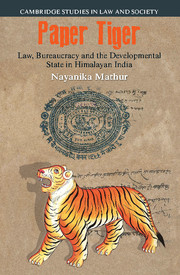Book contents
- Frontmatter
- Dedication
- Contents
- List of Figures
- Glossary
- Acronyms
- Acknowledgements
- Map
- Prologue
- Introduction
- 1 A Remote Town
- The Paper State
- 2 The State Life of Law
- 3 The Material Production of Transparency
- 4 The Letter of the State
- 5 Meeting One Another
- Paper Tiger?
- Conclusion: The State as a Paper Tiger
- References
- Index
2 - The State Life of Law
from The Paper State
Published online by Cambridge University Press: 05 October 2015
- Frontmatter
- Dedication
- Contents
- List of Figures
- Glossary
- Acronyms
- Acknowledgements
- Map
- Prologue
- Introduction
- 1 A Remote Town
- The Paper State
- 2 The State Life of Law
- 3 The Material Production of Transparency
- 4 The Letter of the State
- 5 Meeting One Another
- Paper Tiger?
- Conclusion: The State as a Paper Tiger
- References
- Index
Summary
Ordinarily, Uttarakhand makes an appearance in India's national English-language press only in relation to issues classified as belonging to the realm of ‘nature’. Primary amongst these are calamities such as earthquakes, floods, global warming worries like the melting of the Himalayan glaciers, the damming of rivers, the poaching and trafficking of big cats, discovery of rare herbs, and the occasional paeans to the mesmerising beauty of the holy Himalayas. In the summer of 2006 when I was reconnoitering the State, I was surprised to see Golu, the local folk god of justice, make an appearance in Outlook (a weekly English-language magazine), in a story that has stayed with me. Golu is said to be the son of a king from Champawat, the ancient capital of Kumaon. At birth he was spirited away from his parents by wicked stepmothers. After the mandatory period of struggle, Golu's story ends happily with his ascension to the throne. A shrine to Golu is located at the Chitai temple, 8 km from the hill station of Almora. Devotees of Golu attempt to attract his attention through a device which is intriguing as a form of worship, if familiar in other contexts: they petition him on government stamp paper, exactly as they would any state agency. The article describes this phenomenon:
‘Parampujya (most venerated) Golu, says an appeal, in neat schoolgirl-devnagari script, on non-judicial Uttaranchal stamp paper, help me get through my exams… or, get me a seat in a hostel … get my son a job in Bangalore … heal my father. Below the signature, occasionally, is an address, even a telephone number – just in case he decides to call. The petitioners aren't just from the hills, where Golu is a superstar – his name on trucks and shopfronts, his little icons sold in bazaars, his stories told in folk songs, his spirit invoked at jagars (seances)—but also from the plains of Uttar Pradesh (UP) … Arbiter of land disputes, saviour of the swindled, rescuer of young women thrown out of their homes by nasty in-laws, court of appeal for senior officials protesting unfair transfers. Or even a disgruntled job applicant. Strung up among the petitions and damp with rain is a 13-page 2001 ruling of the UP State Public Service Tribunal, on a complaint filed by a man rejected for the post of solar astronomer. Grievance not tenable, says the ruling.
- Type
- Chapter
- Information
- Paper TigerLaw, Bureaucracy and the Developmental State in Himalayan India, pp. 60 - 80Publisher: Cambridge University PressPrint publication year: 2015

